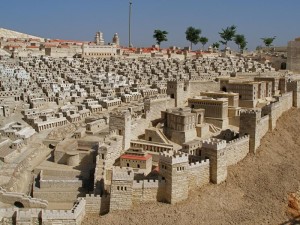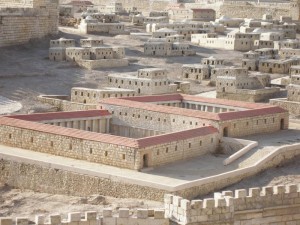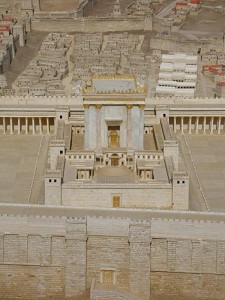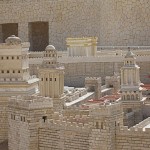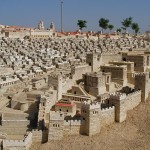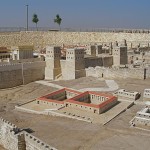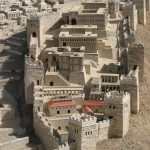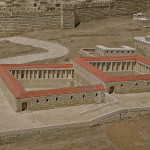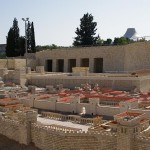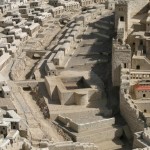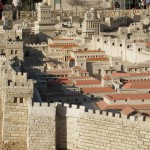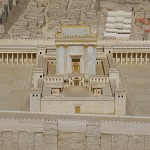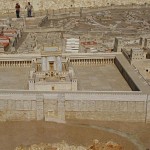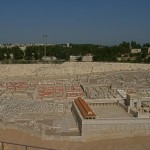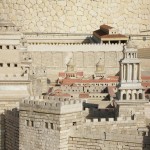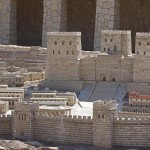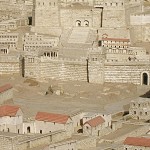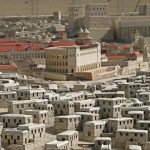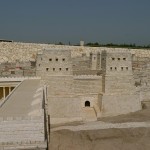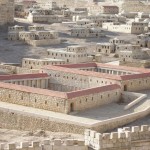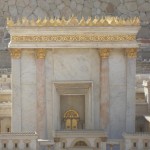Jerusalem
To visualise old Jerusalem at the peak of its power, look down on the outdoor scale model of the ancient city at the Israel Museum.
The gold-trimmed Second Temple and its vast courtyard dominate the Model of Ancient Jerusalem. Herod’s Palace, the twin-spired Palace of the Hasmoneans, the streets and markets are all identifiable.
The time is AD 66, the fateful year the Great Revolt against the Romans erupted, resulting in the destruction of the city and the Temple built by Herod the Great. All that’s missing from the buildings of Jerusalem limestone are the people.
This is also the time when Christianity was in its formative stages and the Dead Sea Scrolls — now housed in the museum’s Shrine of the Book — were being created.
The crucifixion of Jesus Christ was only 36 years before, and the mound of Calvary can be seen just outside the Second Wall (but well inside the new north wall begun by Herod Agrippa I).
The ancient city was then at its largest, spreading over 180 hectares — more than twice the size of the present Old City.
Archaeologists and historians contributed
Construction of the Model of Ancient Jerusalem was undertaken in the 1960s by Hans Kroch, owner of the Holyland Hotel, in memory of his son Jacob, who was killed in the 1948 Arab-Israeli War.
Originally in the grounds of the hotel, it was transported in 1000 pieces to its present site, 5km away, in 2006.
The model covers nearly 4000 square metres, using a scale of 1:50. A human figure on this scale would be about 35 millimetres high.
Archaeologists (principally Professor Michael Avi-Yonah of the Hebrew University of Jerusalem), historians and architects contributed their expertise to the re-creation of ancient Jerusalem.
The main sources used were writings from the Roman period, construction techniques used in ancient cities similar to Jerusalem, and archaeological discoveries from Jerusalem itself.
Subsequent excavations in Jerusalem have enabled the model to be refined and updated archaeologically.
Imagination augmented archaeology
Archaeologist Jerome Murphy-O’Connor says many arbitrary decisions had to be made in the construction of the model, “and imagination often supplied what the texts or archaeologist’s trowel could not provide. The model, therefore, is a hypothesis, a vision of the city as it might have been, and not all elements carry the same guarantee.”
According to Murphy-O’Connor, “The portrayals of the Temple and of the Palace of Herod are excellent, but the presentation of the northern part of the city is almost certainly wrong. The line assumed by the northernmost wall of the model rests on inadequate archaeological evidence, and all the buildings it encloses are the product of pure imagination.”
Another feature which appears to lack archaeological basis is the red-tile roofing. No roof tiles have been found in excavations of Jerusalem, however there are too many tiles in the model to make a change.
Visitors may walk around the model, though there is no protection from sun or rain. They are not allowed to walk inside the walls.
Administered by: The Israel Museum
Tel.: 972-2-6708811
Open: Sun, Mon, Wed, Thurs 10am–5 pm; Tues 4–9 pm (Aug 10am-9pm); Fri and holiday eves 10am–2pm; Sat and holidays 10am–5pm
- Three towers built by Herod, the Phasael (left), the Hippicus and the Mariamme (Seetheholyland.net)
- Looking from the lower city to the Herodian towers of the upper city (Seetheholyland.net)
- Pools of Bethesda and Antonia Fortress (Seetheholyland.net)
- Royal palaces of Jewish convert Queen Helena of Adiabene in the lower city (© Tom Callinan / Seetheholyland.net)
- Pools of Bethesda (© Deror Avi)
- Herod’s Palace (with orange roofs) immediately inside the western city wall (Seetheholyland.net)
- Pool of Siloam (Tom Callinan / Seetheholyland.net)
- Herod’s Palace (with orange roofs) (Seetheholyland.net)
- Second Temple of Jerusalem, destroyed in AD 70 (Seetheholyland.net)
- Temple and its courts, with Antonia Fortress at right (Seetheholyland.net)
- Lower city (left) and Temple Mount (Tom Callinan / Seetheholyland.net)
- Hasmonean Palace flanked by Phasael (left) and Mariamme towers (Seetheholyland.net)
- Antonia Fortress and, left, markets in the northern Tyropoeon Valley (Seetheholyland.net)
- Rock of Calvary (centre) outside the Second Wall (Seetheholyland.net)
- Herod’s Theatre (© Tom Callinan / Seetheholyland.net)
- Antonia Fortress, joined to the north-west corner of the Temple (© Tom Callinan / Seetheholyland.net)
- Pools of Bethesda (Seetheholyland.net)
- Gold-trimmed facade of the Temple (Seetheholyland.net)
References
Lefkovits, Etgar: “Second temple model to link history, archaeology”, Jerusalem Post, May 25, 2006
Miriam Simon: “Jerusalem’s Glory Days”, Eretz, September-October 2006
Blaiklock, E. M.: Eight Days in Israel (Ark Publishing, 1980)
Murphy-O’Connor, Jerome: The Holy Land: An Oxford Archaeological Guide from Earliest Times to 1700 (Oxford University Press, 2005)
External link

